All About Automotive Industry: Segments, Value Chain and Competitive Advantage
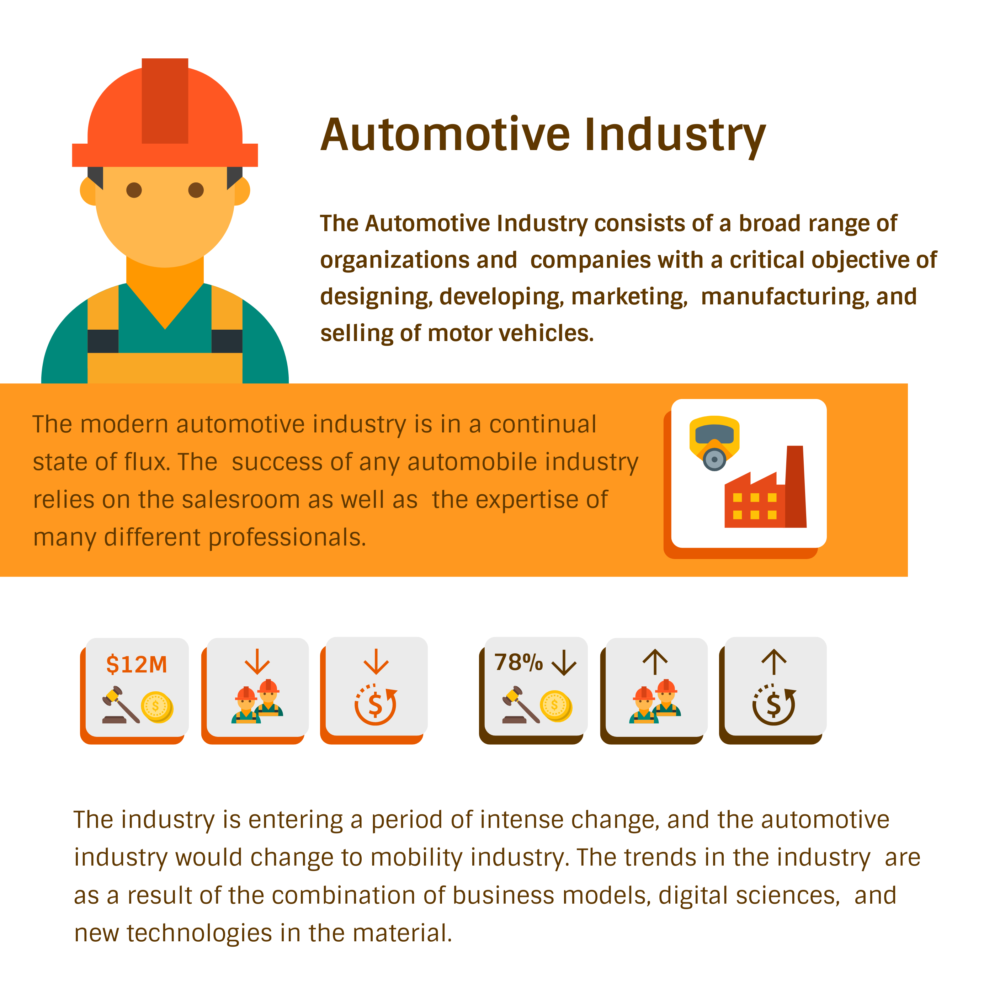
The Automotive Industry consists of a broad range of organizations and companies with a critical objective of designing, developing, marketing, manufacturing, and selling of motor vehicles. The automotive industry makes a vital part of the world's economic sectors by revenue Automobiles, however, are not entirely included in the industry. The industry also does not include companies or organizations dedicated to the maintenance of automobiles such as fuel filling stations and automobile service and repair shops.
The industry consists of producers, however not limited to original equipment manufacturers (OEMs). The original equipment manufacturers consist of light trucks, cars, heavy equipment, heavy trucks, and motorbike manufacturers. Another category in the original equipment manufacturers includes; wholesalers and automotive suppliers, distributors, dealers, and importers.
Companies in the automotive industry fall into two categories that are car manufacturers and car parts manufacturers. Vehicles in the modern world are becoming more complex and involve more electronic parts than in the past years. It, therefore, increases the number of components manufactured by suppliers rather than the manufacturers.
The modern automotive industry is in a continual state of flux. The success of any automobile industry relies on the salesroom as well as the expertise of many different professionals. The sector offers numerous employment opportunities in several positions such as mechanical, sales, assembly, financial, creative, scientific, technical, and business position. Other employment opportunities in the manufacturing plants of the automotive industry include quality control workers, safety engineers, managers, supervisors, designers, and executives.
Since car manufacturing is expensive, there are a few numbers of manufacturers in the automotive industry. Globally the world leaders in the automotive sector include Toyota, Honda, Volkswagen, Nissan Motors, and Hyundai. The automotive industry is also an example of a mixed oligopoly. It is because it has only a few producers who produce differentiated products.
The industry is entering a period of intense change, and the automotive industry would change to mobility industry. The trends in the industry are as a result of the combination of business models, digital sciences, and new technologies in the material.
The transformation of the industry is more about people's connectivity to automobiles. The change in the automotive sector will entail connectivity, autonomous vehicles, redefined mobility, and electrification. The integration of mobile information to the industry would also set a pathway for predictive maintenance that monitors and warns consumers about the operational performance of the automobile.
What are the Key Segments in Automotive Industry?
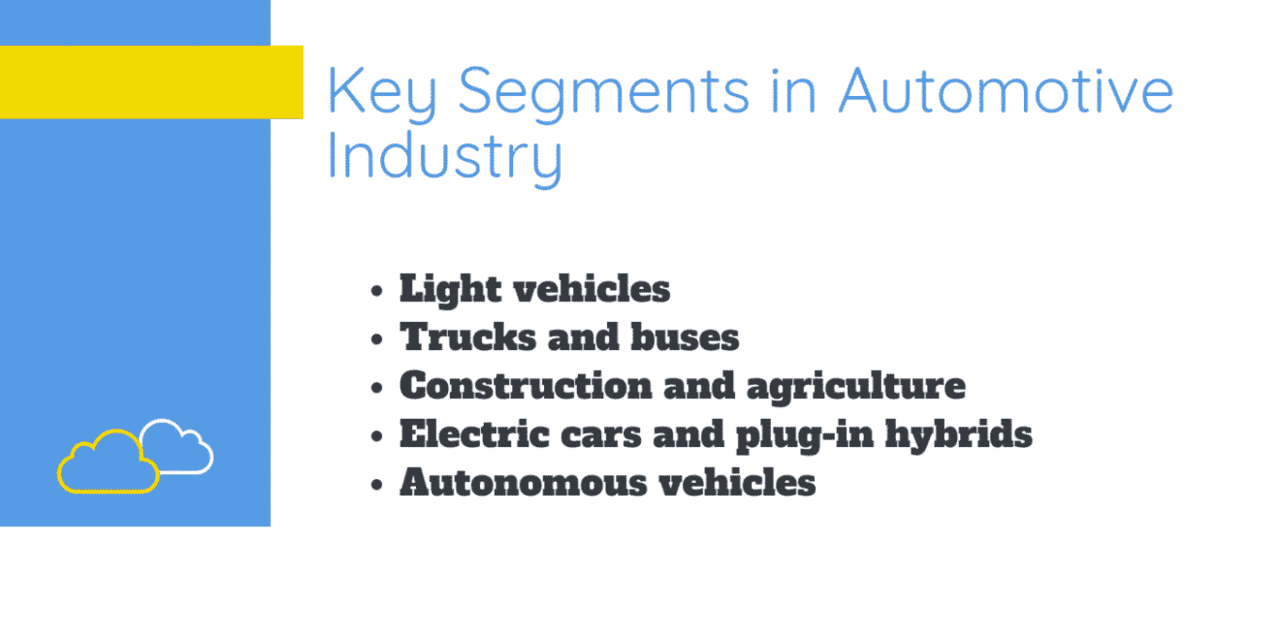
What are the Key Segments in Automotive Industry
- Light vehicles: These are motorcycles and cars used for business transportation involving goods and people. Examples include SUVs, passenger cars, minivans, and pick-up trucks.
- Trucks and buses: They are mainly commercial vehicles used for transportation of goods and people. Examples include coaches, trailers, and light and heavy buses.
- Construction and agriculture: Is any industrial machinery used for mining, agricultural and construction transportation tasks. Examples include earth movers and commercial vehicles.
- Electric cars and plug-in hybrids: Include automobiles propelled by a single or several electric motors. They use electrical energy stored in rechargeable batteries. The electric motors provide electric cars with instant torque, thus creating a stable and smooth acceleration.
- Autonomous vehicles: These are self-driving, driverless or robotic cars that can sense their environment and navigate without human input. They use global positioning system, radar, and computer vision to detect their surroundings.
What are the Automotive Industry Value Chain?
The value chain covers all the activities starting from conception of the product to the final delivery in the hands of a customer. In cases where the company involved deals with the production of goods, their value chain commence from the acquisition of raw materials. The processes in the value chain add value to the product until its ready for sale. Analysis of the value chain helps in analyzing and identifying where problems are to make improvements and increase the efficiency of the operations. A compelling value chain analysis would also assist in generating competitive advantage. The value chain of the automotive industry starts from:
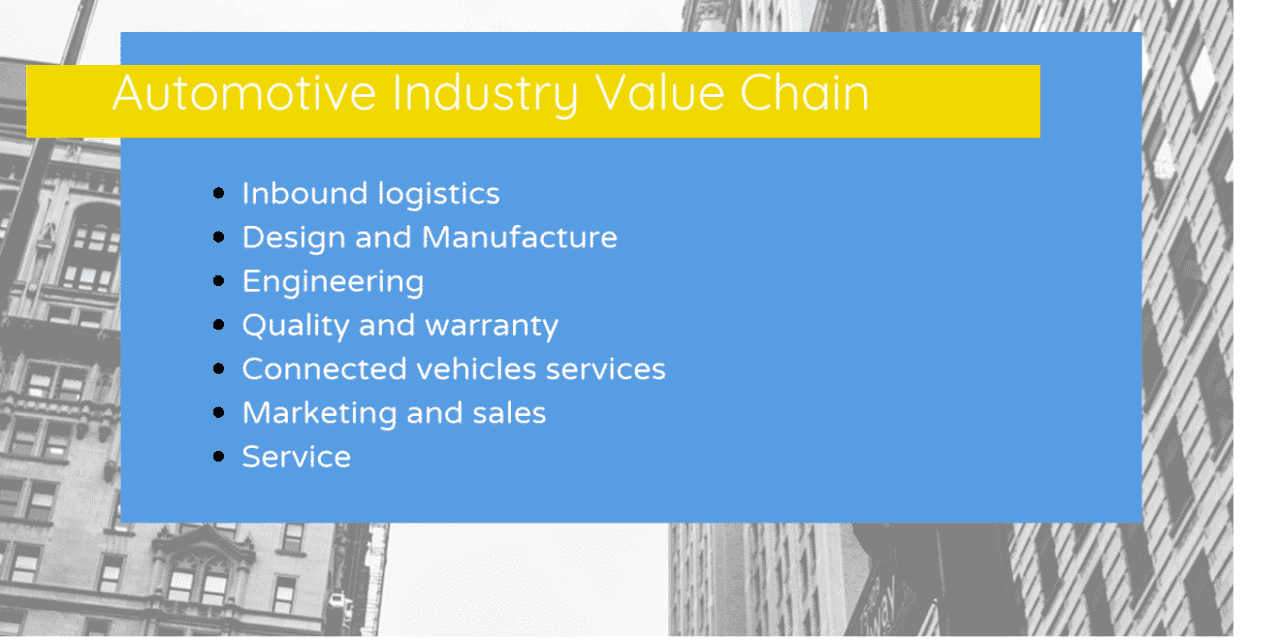
What are the Automotive Industry Value Chain
- Inbound logistics: It is the initial step in the line of production. The action involves receiving of raw materials from suppliers who are in different locations all over the world. After acquiring the raw materials, they industry distributes them among the manufacturing units based on the requirement.
- Design and Manufacture: It deals with operations. Operations covered the main production stage and divided into several parts. This step involves converting of raw materials into the product. Some of the producers in the automotive industry have their operations and manufacturing units scattered all over the world helping them to save costs on shipping their products to regional markets.
- Engineering: In this step, it primarily deals with the flexibility of the engineers to manufacture vehicles. It also involves minimizing of engineering times by researching and developing solutions. Engineers also have to ensure the production line is more flexible by planning and designing new production processes.
- Quality and warranty: It is an important part that touches all parts of the automotive industry. The agreement among suppliers and industry practitioners in the automotive sector on what should entail any quality and warranty program are; managing of corrective actions to improve the quality of products, tracking and managing aspects of warranty operations, and analyzing contributing factors and failures to warranty cost. With this, OEMs and suppliers will be in good terms.
- Connected vehicles services: These involve services that enable a car to share internet access with other devices. The facilities also consist of specialized technology that taps into the internet to offer additional benefits to the driver.
- Marketing and sales: It is a critical part of the value chain to vehicle producing companies. This part includes distribution, management of sales force, advertising, promotions, and management of customer relationship. The objective of this step is ensuring that the product reaches to the targeted consumer segment as well as making the target market aware of the products' advantages and features. The focus of marketing and sales is driving up profitability and sales for the automobile company. These automobile companies use online and traditional channels to advertise and market their brands to remain competitive in the industry.
- Service: It is the final activity in the automotive industry value chain and which adds value to the product. It comprises of customer support after the sale of the product by providing continued support relevant to the maintenance of their vehicles. These support activities also ensure that attaining customer retention. By providing better customer support, the brand would have a better image and have a high number of retained customers.
Automotive enterprise resources include;
They are also known as support activities that support the primary activities in the value chain. They include;
- Infrastructure: The organizational structure is the backbone for success in the automotive industry. It comprises of management of culture, organizational structure, finance, and other enterprise resources. With a well-managed infrastructure, the company will have a higher chance of creating profits.
- Information technology: Technology plays a vital role in the automotive industry commencing from the first stage of its value chain to the final product's marketing and sales. With technology, the automotive industry can achieve passenger safety, control over emissions, and vehicle design. Technology has also influenced rider convenience and analysis on of customer buying pattern.
- Finance and Procurement: Management of procurement is a vital support activity down the value chain of the automotive industry. It comprises of acquisition of raw materials from suppliers. Managing procurement helps in saving costs and ensuring production of reliable and efficient vehicles from the quality raw material.
- Human resource management: Managing human resource is a vital focus area for all vehicle brands. Motivated and well managed human capital is the key to success in the automotive industry. With management of human resource, the company can focus on all parts of HRM starting from control of performance to training and recruitment.
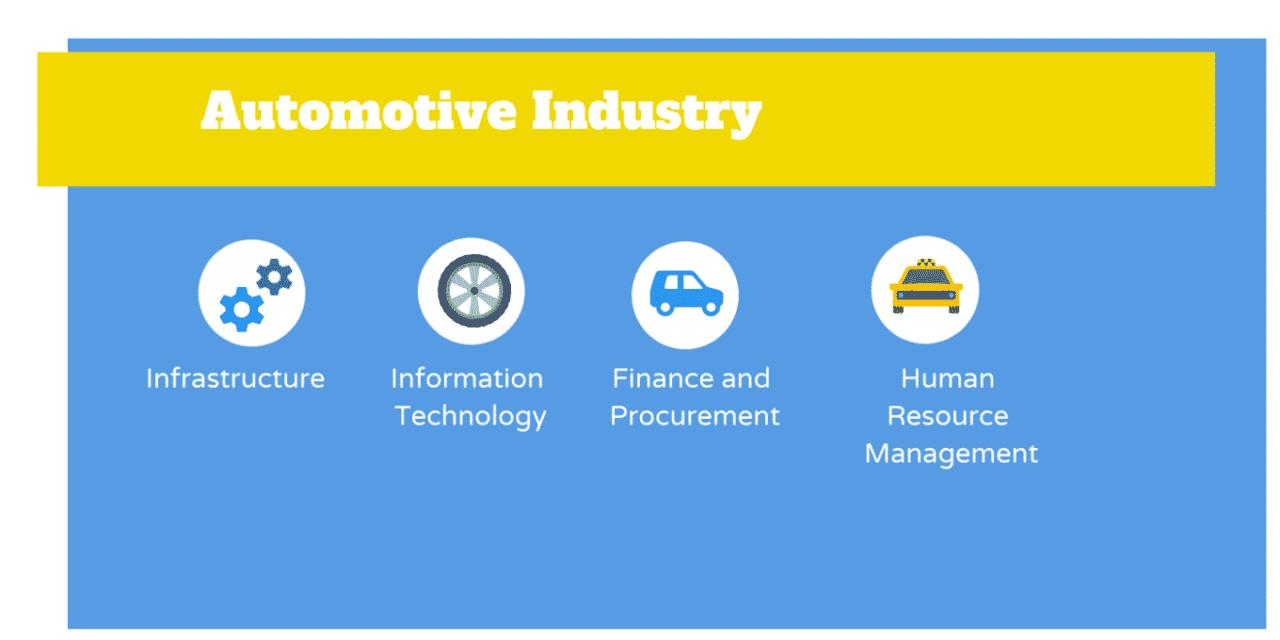
How to Select the Best Software for Automotive Industry
What are the Key Terms in Automotive Industry?
- Advanced driver assistance systems (ADAS): Conventionally, ADAS technology enables the car to detect objects, perform necessary clarification, and alert the driver of any hazardous road conditions. In other cases, the ADAS technology can slow down or stop the vehicle. It also brings applications such as blind spot monitoring, forward collision warnings, and lane change assistance.
- Autonomous vehicles: They are self-driving vehicles. The technologies used in these vehicles offer significant benefits that reduce crashes, reduce fuel consumption, congestion and increase mobility.
- Internet of Things (IoT): Technologies in the IoT perform various tasks such as linking to smartphones, registering real-time alerts, offer emergency roadside assistance among others. Vehicles also will have the ability to send and receive data.
- Telematics: These are methods of monitoring a vehicle through the combination of a GPS system with onboard diagnostics. Through this combination, one can map and record exactly where a car is and how fast it is traveling as well as how the car is behaving internally.
- Electric vehicle (EV): It is a vehicle operating with a single or several electric motors using energy stored in rechargeable batteries. There are three types of EVs based on the degree of electricity they use. They are;
- Hybrid-electric vehicles (HEVs): They generate their power from both electricity and petrol. The car's braking system makes its electric energy to recharge the battery.
- Plug-in hybrid-electric vehicles (PHEVs): They generate their power from both petrol and electricity. They use plugging-in to an external charging outlet and regenerative braking to recharge their battery.
- Battery electric vehicle: They are fully electric vehicles and use an external electrical charging outlet to charge the battery.
What are the Competitive Advantage in Automotive Industry?
- Time to market: In staying more competitive, the automotive industry has to have a short time to sell. It would, therefore, give the company the advantage when it comes to innovation, allowing them to reach more clients with new products before their competitors. A perfect example is the Toyota Company.
- Quality: High warranty costs are often a great indication that the processes within are of high quality. Having high quality would, therefore, translate to an increase in customer satisfaction.
- Forecasting: It is a vital aspect that addresses the future demand for the car. Predictions based on judgmental factors provide demand information about the vehicle. Forecasting on demand the company would be able to increase the operation cost in cases where the need is overstock.
- Inventory management: Warehouses of automotive industries are in different places. Therefore inventory managers have always to update their inventory to help the industry keep up with the mobility needed by the modern automotive industry.
Top Quality Management Software
Top Inventory Management Software
What is Automotive Industry?
The Automotive Industry consists of a broad range of organizations and companies with a critical objective of designing, developing, marketing, manufacturing, and selling of motor vehicles. The automotive industry makes a vital part of the world's economic sectors by revenue Automobiles, however, are not entirely included in the industry.
What are the Key Segments in Automotive Industry?
The Key Segments in Automotive Industry includes Light vehicles, Trucks and buses, Construction and agriculture, Electric cars and plug-in hybrids and Autonomous vehicles.
What are the Automotive Industry Value Chain?
The value chain covers all the activities starting from conception of the product to the final delivery in the hands of a customer. In cases where the company involved deals with the production of goods, their value chain commence from the acquisition of raw materials.
What are the Competitive Advantage in Automotive Industry?
The Competitive Advantage in Automotive Industry Time to market, Quality, Forecasting, and Inventory management.




















































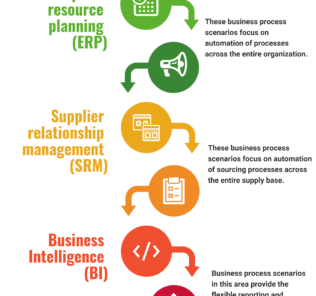




By clicking Sign In with Social Media, you agree to let PAT RESEARCH store, use and/or disclose your Social Media profile and email address in accordance with the PAT RESEARCH Privacy Policy and agree to the Terms of Use.